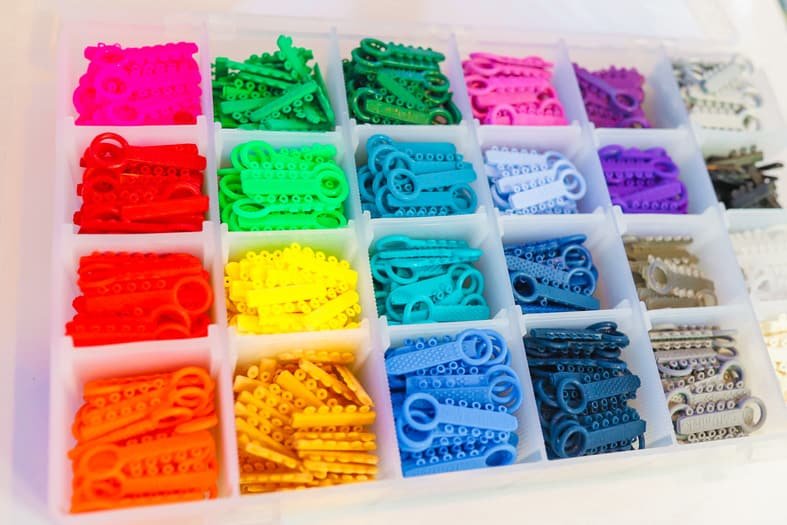Metal Braces
BANDS
Orthodontic bands are custom shaped metal bands that fit around the teeth. Special cement is used to hold the bands firmly in place until it is time to remove them. Bands are used to hold brackets (braces) and appliances (expanders, space maintainers) firmly to the teeth. Because of their strength bands are often used in situations where regular bonded brackets would break off.
Bands can be placed on any tooth, but by far the most common tooth to have a band is a molar. Molars are the largest teeth in the mouth and are often used as anchors, meaning they have to hold against larger forces. For example, bands are placed on molars when Bitejumpers are needed during treatment. Molars are also the teeth of choice for holding certain orthodontic appliances in place, such as expanders, trans-palatal arches, space maintainers, lingual arches, and the Nance appliance. Molars are found in the back of the dental arches and therefore receive the heaviest vertical forces when chewing. Because of these unique roles that molars play they often have bands placed for orthodontic treatment.
Another reason for using an orthodontic band is to attach a bracket to a tooth to which it otherwise would not have a strong bond. Certain crowns and fillings do not bond well with the dental composite used to place brackets. If a particular tooth has a dental restoration (filling, crown) that does not bond well to brackets, or if a bracket consistently breaks off during treatment, a band may be placed instead.
Placing and cementing bands
Before a band can be placed comfortably around a tooth, a small amount of space will need to be created between that tooth and the tooth next to it. To create this space a small elastic, called a separator or spacer, will be flossed between the teeth and left in place for about one week. Separators are normally placed the week before getting braces on or being fitted for an orthodontic appliance.
If a band becomes loose, comes off completely, or is damaged during treatment, please call our office for further instructions. As with most orthodontic appliances, very sticky foods as well as hard, crunchy foods should be avoided if you have bands placed. Popcorn is particularly problematic with orthodontic bands, as the small pieces of kernel shells can get caught in the gums, underneath the band causing inflammation and infection.
COLORS
There are so many colors of braces to choose from here at Johnsonlink Orthodontics. The best part about having braces, is having FUN with them! You get to choose a different color at every appointment or even alternate colors. The most popular colors for braces are shades of pink, blue, and silver. We have some advice when choosing your colors: Go with your favorite color! Pick a color that you LOVE. Or choose more than one color, like the rainbow! Color of the month! This is a great way to choose a color if you are indecisive. It is our way to connect with our patients and have some fun. You can choose our color of the month and get entered into our drawing. Holiday fun! It’s great to choose your colors based on the holiday coming up. You can choose multiple colors for all the holidays, such as Valentine’s day, St. Patrick’s day, Halloween, Christmas, etc. You can also choose colors based on weddings, graduations or any other special occasion. Sports teams! This is a great way to represent your favorite sports teams! School Spirit! Show your school pride by putting your school’s colors on display! The great thing about being in braces for awhile is that you can try every color combination that you want! Don’t be afraid to pick a colorful braces combination.
Bitejumpers
Bitejumpers", also known as "Forsus Springs", are a type of class II bite corrector. A class II bite is commonly known as an "overbite", or "overjet", and describes a bite where the upper teeth are positioned too far forward compared to the lower teeth. In many cases this makes a "bucked tooth" look, where the upper front teeth stick out. Bitejumpers are used to correct this type of bite.
Bitejumpers are springs that connect to the braces from the upper back teeth to the lower front teeth. Since they are connected to the braces they do not need to be removed or replaced by the patient, and instead remain in place until they are removed by us. They are designed to move freely, allowing the patient to talk and chew normally, and are almost completely hidden from view. This is a huge improvement from the traditional headgear, which is unsightly and requires the patient to put it on and take it off themselves.
The typical treatment with Bitejumpers starts with the placement of a full set of braces, including bands on the molars. Bitejumpers are usually placed after six to nine months and take about six to nine months to complete their portion of the bite correction. Because we always expect a small amount of relapse after removing the Bitejumpers, we typically overcorrect the overbite before removing them. This means that a patient may develop an underbite (where the lower teeth stick out further than the upper teeth) just before the Bitejumpers are removed. This underbite is not permanent and is completely normal for patients in Bitejumpers. After the Bitejumpers are removed it is not uncommon to then go through a period of elastic wear, where patients are asked to wear rubber bands between the upper and lower braces.
Because the Bitejumpers are mobile and adjustable, they may come apart when a patient opens their mouth wide, as when yawning. There are two major parts of the Bitejumpers, the spring (attached to the upper molars) and the arm (attached to the lower wire). When opening the mouth really wide the arm may come out of the spring. The arm can be replaced by openening wide, compressing the spring and fitting the arm back into the spring. If you have a Bitejumper that has come apart and are having trouble getting it back together please call our office for assistance.
ELASTICS
Elastics for braces are also known as rubber bands. They serve a valuable function by helping move your teeth into proper alignment during treatment. The first and most important thing when it comes to elastics is to make sure you wear them every day! At first, elastics may feel awkward to put on and may be difficult but with practice you will become a pro! Elastics are usually made of latex but also come in latex-free for patient’s with sensitivities. Your braces by themselves do a great job of aligning your teeth but there are certain bite problems that can’t be fixed with braces alone. This is where elastics come in. There are a few bite problems that elastics can fix. When you start wearing elastics, teeth may become sore. Being consistent helps direct the teeth in the correct position while reducing the initial discomfort.
SEPARATORS
Separators, or spacers, are small elastic bands that are flossed between teeth where space is needed. The most common reason for placing separators is to create space for metal bands to be placed on the tooth or teeth next to the separator. These bands fit around the teeth and may hold a bracket (braces) or be a part of another appliance, such as an expander or space maintainer. Other reasons for separators include helping an impacted, or blocked out tooth to erupt and creating space. With separators, you need to avoid any sticky, chewy or gooey foods (such as caramel, gum, taffy, etc.). Be sure to not floss around the separators or you will pull them out.







